
Solanum is a large and diverse genus of flowering plants, which include three food crops of high economic importance: the potato, the tomato and the eggplant. It is the largest genus in the nightshade family Solanaceae, comprising around 1,500 species. It also contains the so-called horse nettles, as well as numerous plants cultivated for their ornamental flowers and fruit.

A vine is any plant with a growth habit of trailing or scandent stems, lianas, or runners. The word vine can also refer to such stems or runners themselves, for instance, when used in wicker work.
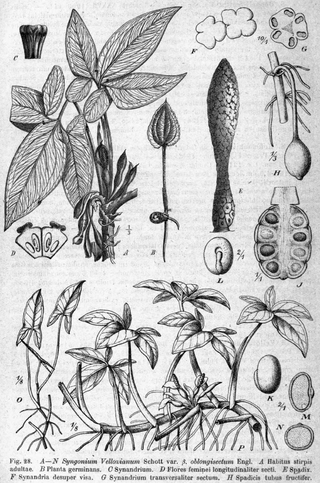
Syngonium is a genus of flowering plants in the family Araceae, native to tropical rainforests in southern Mexico, the West Indies, Central and South America. They are woody vines growing to heights of 10–20 m or more in trees. They have leaves that change shape according to the plant's stage of growth, and adult leaf forms are often much more lobed than the juvenile forms usually seen on small house plants. The scientific name of the genus comes from the Greek words σύν and γονή and refers to the fused ovaries of female flowers.

Solanum mauritianum is a small tree or shrub native to South America, including Northern Argentina, Southern Brazil, Paraguay and Uruguay. Its common names include earleaf nightshade, woolly nightshade, flannel weed, bugweed, tobacco weed, tobacco bush, wild tobacco and kerosene plant.

Ipomoea cairica is a vining, herbaceous, perennial plant with palmate leaves and large, showy white to lavender flowers. A species of morning glory, it has many common names, including mile-a-minute vine, Messina creeper, Cairo morning glory, coast morning glory and railroad creeper. The species name cairica translates to "from Cairo", the city where this species was first collected.

Jasminum polyanthum, the many-flowered jasmine, pink jasmine, or white jasmine, is a species of flowering plant in the olive family Oleaceae, native to China and Myanmar. A strong evergreen twining climber, it is especially noted for its abundant, highly fragrant pink to white flowers.
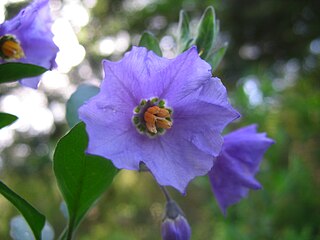
Solanum xanti, known commonly as chaparral nightshade, purple nightshade, and San Diego nightshade, is a member of the genus Solanum. It is native to the Western United States in Arizona, California, Nevada, and Oregon, and to northwest Mexico in Baja California.
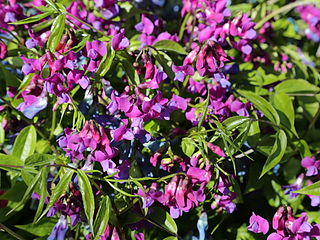
Lathyrus vernus, the spring vetchling, spring pea, or spring vetch, is a species of flowering herbaceous perennial plant in the genus Lathyrus, native to forests of Europe and Siberia. It forms a dense clump of pointed leaves with purple flowers in spring, shading to a greenish-blue with age.

Brunfelsia pauciflora is a species of flowering plant in the family Solanaceae, the nightshades. It is endemic to Brazil, and it is grown in cultivation. A shrubby perennial plant grown in gardens, its common names include today, tomorrow together, yesterday, today and tomorrow, morning-noon-and-night, kiss me quick, and Brazil raintree.

Fumaria muralis, known as common ramping-fumitory or wall fumitory, is a flowering herbaceous plant in the poppy family (Papaveraceae) native to western Europe and northwestern Africa.

Solanum diphyllum, commonly known as the twoleaf nightshade, is a species of nightshade native to the Americas. It is cultivated as an ornamental plant for its clusters of dark green round fruits that turn a bright yellow when ripe.

Solanum opacum is a species of flowering plant in the family Solanaceae. It is referred to by the common names green berry nightshade, or morelle verte and is a sprawling annual native to eastern Australia. It is part of the black nightshade group of Solanum species.
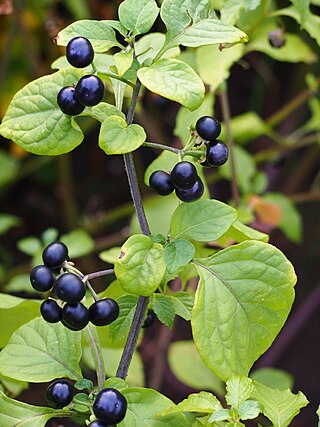
Solanum scabrum, also known as garden huckleberry, is an annual or perennial plant in the nightshade family. The geographic origin of the species is uncertain; Linnaeus attributed it to Africa, but it also occurs in North America, and it is naturalized in many countries. In Africa it is cultivated as a leaf vegetable and for dye from the berries.

Solanum villosum, the hairy nightshade, red nightshade or woolly nightshade, is a sprawling annual weed in Europe, western Asia, northern Africa and is also naturalized in Australia and North America.

Trachelospermum asiaticum, the Asiatic jasmine, is a species of flowering plant in the family Apocynaceae and it is native to Asia. Its flowers resemble stars, so it is also referred to as yellow star jasmine or Asian star jasmine. This is a fast growing evergreen vine, often used to cover fences, walls, and similar surfaces. It is heat- and cold- tolerant, and grows even in shady areas.

Serruria elongata or long-stalk spiderhead is a plant belonging to the protea family. It is an erect, hairless shrublet of 1–1½ m (3½–5 ft) high with densely set, alternate, finely divided leaves lower down the plant, with needle-like segments. On top of an up to 30 cm (12 in) long inflorescence stalk are several, loosely arranged heads of pin-like, densely silvery-haired flower buds, each of which opens with four curled, magenta pink corolla lobes. The species is endemic to the southern Western Cape province of South Africa. It flowers during the southern hemisphere winter and early spring, between June and September.
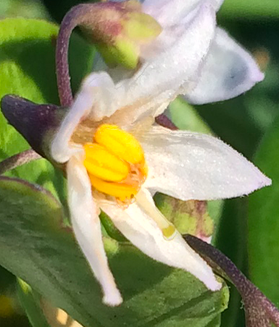
Solanum africanum is a species of plant in the nightshade family. It is found in South Africa. This plant typically occurs near the coast up to an altitude of 200m.
Larsenianthus careyanus is a species of the ginger family (Zingiberaceae). It occurs in Bangladesh as well as northeast India. It is the type species of the genus Larsenianthus, which was newly established in 2010.

Solanum petrophilum, commonly known as rock nightshade or prickly nightshade, is an Australian native perennial herbaceous plant that belongs to the family Solanaceae. Solanaceae has a worldwide distribution and also contains important food species such as the tomato, peppers, and potatoes.






















